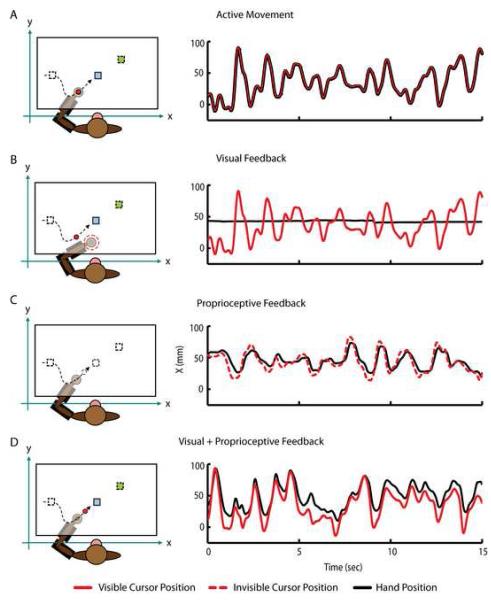Figure 1.
Experimental apparatus and trajectories during the active movement, visual, proprioceptive and visual +proprioceptive playback phases. The monkey performs the random target pursuit (RTP) task in the horizontal plane using a two-link exoskeletal robot. Direct vision of the arm is precluded. During the RTP task the monkeys moves a visual cursor (red circle) to a target (blue square). The target appeared at a random location within the workspace (10 by 6 cm), and each time the monkey hits it, a new target appeared immediately in a new location selected at random (green square). In order to complete a successful trial and receive a juice reward, the monkey was required to sequentially acquire seven targets. (A) During Active Movement, the position of the visual cursor (red trace) was controlled by the movements of the monkey’s hand (black trace). (B) During Visual Playback, target positions (squares) and cursor trajectories (red circle) recorded during the Active Movement condition are replayed while the animal voluntarily maintains static posture in the robotic exoskeleton. If the monkey moves his hand outside of the hold region (dashed red circle) the current trial is aborted and the cursor and target are extinguished until the hand is returned. The right panel shows the X dimension of the visual cursor (red trace) and hand movement (black trace). (C) During Proprioceptive Playback condition, the monkey’s hand is moved through the cursor trajectories recorded during Active Movement. Here, the visual cursor and target are invisible (dashed black circle and squares). The right panel shows how the hand (black trace) is driven through the same trajectory as the invisible visual cursor (dashed red trace) providing Proprioceptive Playback condition. Notice how the hand trajectory lags behind the cursor trajectory due to the dynamics of the position controller/exoskeleton (D) During the Visual+Proprioceptive Playback condition, target positions (squares) and cursor trajectories (red circle) recorded during the Active Movement phase are replayed and the monkey’s hand is moved through the cursor trajectories by the exoskeleton. The right panel shows how the visual cursor (red trace) and hand (black trace) move through the same trajectory in the X dimension. Again, hand movement lags slightly behind the movement of visual cursor due to position controller/exoskeleton dynamics. In all conditions, the same trends were observed in the Y dimension.

